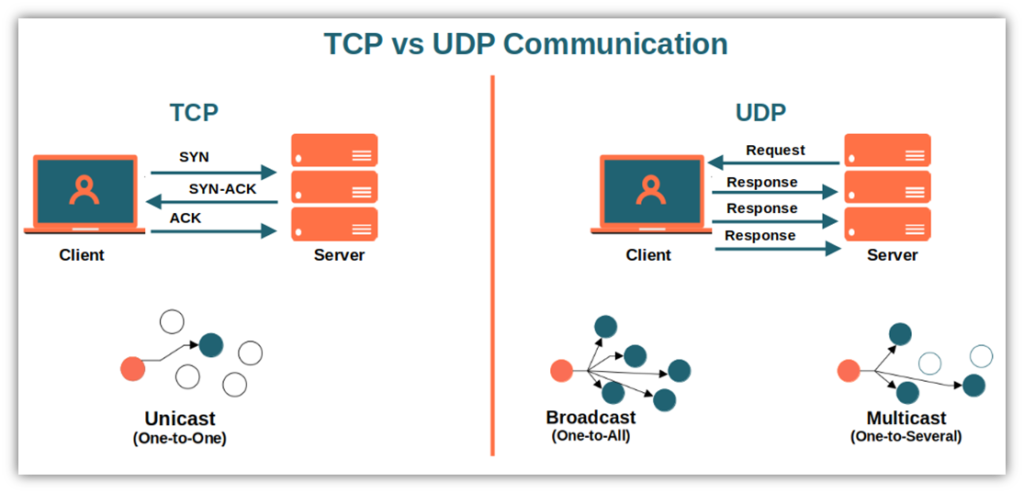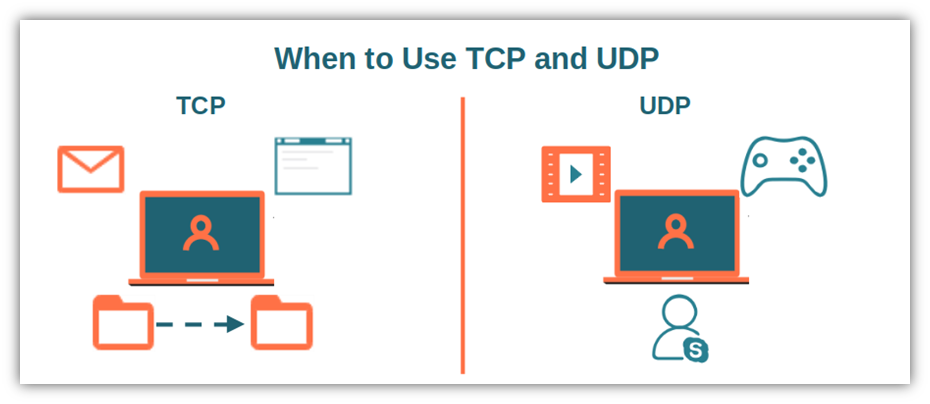TCP or UDP? Reliability or speed? Discover the key differences between the two most widely used network protocols that can make or break your internet experience. Learn when to use TCP and when it’s better to opt for UDP. Get to know your data transfer protocols now!
In 2021, internet connectivity was estimated to reach 63% of the world’s population. That’s huge when you consider that in 2018, only 49% of global users had access. Our lives are more connected than ever before as confirmed by recent statistics.
- The 100 top streaming websites reached 44.3 billion visits globally.
- Amazon.com recorded 2 billion visits in the U.S. alone between January 2021 and 2022.
- Ebay.com received 844.9 million total visits in just one month.
We use the internet in almost everything we do in our increasingly digital world. We simply can’t seem to do without it. But as we rely on the internet to facilitate our daily lives, the internet itself relies on network protocols to function. In our previous articles, we’ve taken you to the core of the TCP model and the UDP protocol, two of the world’s foremost transport protocols. You’ve learned about their features and how they work, as well as about their advantages and disadvantages.
Now, in the last part of our journey, you’ll discover the differences between TCP and UDP. We’ll help you understand the tradeoffs between the two network protocols and explain why TCP can be a better option for some applications and UDP for others. Making the right choice is never easy, but if you stick with us, you’ll be able to make an informed choice for your networking needs. Ready, set, action!
TCP/IP and UDP: The Internet’s Basic Communication Protocols
You’ve just downloaded a new virtual private network (VPN) software. You start going through the settings and notice that there are two network communication protocol options. Which one do you select? The answer depends on your specific needs.
- TCP/IP. The transmission control protocol/internet protocol (TCP/IP). This is a connection-oriented protocol is used by most devices to communicate over the internet. It provides error-checking and guaranteed data delivery. In one word: it’s reliable and ensures you don’t miss anything important.
Or,
- UDP. The user datagram protocol. It’s a connectionless protocol that’s similar to TCP/IP but much simpler. It fires data like a machine gun, but it doesn’t bother with errors or failed deliveries. In one word: it’s fast, but you may not always receive 100% of the data.
Reliability or speed? That is the question. OK, it’s not exactly what Shakespeare wrote in one of his plays, but the essence is the same: making a choice is not always easy.

They’re both major protocols, both enable devices to connect to the internet, and both use the IP protocol. So, what is the difference between TCP and UDP if they’re so similar? Let’s compare them!
TCP vs UDP: What Is the Difference Between TCP and UDP?
Network connection protocols are a bit like people, they’ve one thing in common: they’re all different. And so are TCP and UDP.
For those of you short on time, here’s a summary of their differences:
| TCP | UDP | |
| Connection Type | Connection-oriented — The device must establish a connection before transmitting data (handshake included) and close the connection after transmission. | Connectionless — No connection and no handshake are required to send data. |
| Reliability | Reliable — Data packet delivery is guaranteed. | Unreliable — Datagrams delivery isn’t guaranteed. |
| Communication Information Type | Stateful —The client and the server keep the information about the session. | Stateless — The server doesn’t keep any information about the session. |
| Header Size | Variable — 20-60 bytes header length. | Fixed — 8 bytes. |
| Speed | Slower than UDP as it follows many steps to ensure accuracy. | Faster than TCP as it’s a much simpler protocol. |
| Sequence | All packets are delivered to the recipient in a specific order. | Datagrams are delivered in no specific order. If it’s required a kind of order, it has to be managed by the application. |
| Broadcast Support | No broadcast or multicast are supported. | Broadcast and multicast are supported in addition to unicast. |
| Error Detection Mechanism | Extensive error detection provided: Flow control. Congestion control. Acknowledgment of data. | Basic error detection provided: Checksums. |
| Overhead | Resource intensive. | Lightweight. |
| Protocols | HTTP, HTTPs, FTP, SMTP, and Telnet. | DNS, DHCP, TFTP, SNMP, RIP, and VoIP. |
| Applications | Web browsing. File transfer. Email (SMTP, IMAP/POP) | VPN. Video and music streaming. Online games, multiplayer games. Live broadcasts and video conferencing. Domain name system (DNS) queries. Voice over IP (VoIP). |
Want to know more? Why don’t we check them out one by one?
TCP vs UDP: Connection Type
TCP is a connection-oriented protocol, thus it must establish a connection between the sender and the receiver before sending data.
UDP doesn’t need to do that as it’s connectionless.
We like TCP: It uses a three-way handshake to establish a connection and requires data to be delivered in a specific order, making it more reliable. When you enter your password on a website, you want a reliable connection that ensures your packets are delivered in the right order.
Why we like UDP: As it doesn’t have to establish a connection via a handshake, it’s faster and much more efficient.
TCP vs UDP: Reliability
TCP is very reliable. It guarantees that the data will be delivered to the recipient, no matter what. Any lost data will be recovered and resent. Every packet will be checked for errors and tracked.
UDP is not reliable. It’s the “I don’t care” protocol. There is no double-checking and no data recovery. If a datagram is gone, it’s gone for good. Did the recipient receive the data? Fine. They didn’t receive the data? It’s also fine.
Why we like TCP: When details matter, it’s the perfect protocol. Because when you have to transfer your last PowerPoint presentation to your boss, you want him to get it in full, not only 2 or 3 pages out of the 20 you made.
Why we like UDP: When small glitches are unimportant, then UDP it’s great. Because when you’re playing your favorite online game, you need a fast connection. Will you get all the datagrams? Probably not. Is it critical? Nope.
TCP vs UDP: Communication Information Type
TCP is a stateful protocol. When the client sends a request to the server, it requires a response. If it doesn’t get it, it’ll resend the request.
UDP is stateless. When the client sends a request to the server, the server sends a reply based on the current state. It doesn’t retain any past session information or status.
Why we like TCP: As it keeps the state of all its sessions, if a transaction is interrupted (think about when writing an email), the context and history have been stored, so you can more or less pick up where you left off.
Why we like UDP: As there is no reference to past transactions, each transmission is independent of the others, requiring fewer resources. Because what happens in Vegas, stays in Vegas. In case of crashes, as there is no state to restore, it goes much faster. You simply restart the server or the application.
TCP vs UDP Header Size
TCP has a variable-length header that can vary from 20 to 60 bytes. Its header size is bigger than UDP ones because it contains more information.
UDP has a fixed-length header of 8 bytes and includes a limited amount of information.
Why we like TCP: The fact that the header contains more information, makes this protocol more reliable and, some would argue, more secure. However, the truth is that TCP isn’t any more secure than UDP; if you want security, you need to add another security-type protocol on top of it (like the transport layer socket, or TLS).
Why we like UDP: Sometimes less is more and in this case, its smaller header contributes to a higher speed.
TCP vs UDP: Speed
TCP is slower than UDP simply because it’s a much more complex and accurate process, including many more steps compared to UDP.
UDP, being a very simple protocol is much faster thanks to its very limited features. It’s a network protocol stripped to the bone.
Why we like TCP: Slower doesn’t mean more or less secure, but it does mean it’s more reliable. TCP takes time to verify the connection to ensure that everything works as it should.
Why we like UDP: When you listen to music you don’t care about capturing every packet of data; what you want is the speed of transmission and that’s what you get from UDP.
TCP vs UDP: Sequence
TCP has a built-in mechanism ensuring that packets are sent and delivered in a specific order.
UDP has no such mechanism: datagrams are sent (and received) in any possible order because they’re totally independent of each other.
Why we like TCP: Even if it may slow down the process, sometimes receiving data in a specific sequence is important. When you’re uploading content to your webpage via FTP for example, the content must be delivered in a predetermined order.
Why we like UDP: When near immediacy is essential, this is the best choice. In a VoIP conversation, you don’t care if a few datagrams are out of order. If you get a small hiccup where the connection lapses for a second, you can always ask the other person to repeat the words you missed. Sure, that can be annoying, but it’s a smoother process than worrying about buffering issues throughout the conversation.
TCP vs UDP: Broadcast Support
TCP supports only unicasting. This means that the only connection possible is the traditional one-to-one and it usually utilizes more bandwidth.
UDP supports many different connections:
- Unicasting. One-to-one connection.
- Broadcasting. One-to-all connection.
- Multicasting. One-to-many (but not all) connection.
Why we like TCP: Great for reliable data transmission from one sender to one recipient. When you enter your credit card information on an HTTPS website, you want to make sure that’s sent to one recipient only, not to everyone!
Why we like UDP: First of all, it’s always great to be able to have more than one option. If this, like broadcasting and multicasting, can also help you save bandwidth, it’s even better.
TCP vs UDP: Error Detection Mechanism
TCP checks and corrects errors.
- It keeps track of received and lost data.
- It ensures that the receiver is not overwhelmed by too many packets at once (flow control).
- It ensures that the number of packets sent, gradually increases till it reaches a specific threshold (congestion control).
UDP can only check errors using checksums — and it’s not mandatory.
Why we like TCP: It ensures that you get what’s sent in the order it was sent. Error-free, corruption-free, out of order free. Because sending a corrupted attachment to your boss would really look dodgy.
Why we like UDP: It does the job quick and dirty. And if you’re feeling picky, you can always get errors and flow control managed by the application using the UDP service. When you’re watching your favorite series, a small glitch here and there won’t prevent you from understanding the episode’s plot.
TCP vs UDP: Overhead
TCP takes its time to transfer data, we already know it. And all those steps to follow are very resource intensive, having a heavy toll on bandwidth.
UDP avoids the overhead associated with connection, error checks, you name it. It’s as light as a feather.
Why we like TCP: Nothing is left to chance. It may need more bandwidth, but in return you’ll get good transmission quality.
Why we like UDP: Sometimes, you have to compromise and trade reliability for bandwidth. Have you ever tried watching live streaming with limited bandwidth? Forget it.
TCP vs UDP: Protocols
TCP: All application-layer protocols requiring high reliability use TCP. The complete list is available on the Internet Assigned Numbers Authority (IANA)’s website.
UDP: All application-layer protocols requiring speed and efficiency use UDP. Once again, the complete list is available on the Internet assigned numbers authority (IANA)’s website.
Why we like TCP: In some cases, reliability is everything. When you check a Wikipedia page, you want to be able to see all the content, not only one quarter of the page.
Why we like UDP: It’s perfect for DNS queries. When a potential customer types your ecommerce store’s URL address on its browser, you want them to be able to view it quickly or they’ll be annoyed and move on to another online shop.
TCP vs UDP: Application
We’ve already seen quite a few practical examples of TCP and UDP applications. To summarize:
TCP is mainly used when it’s required a reliable transmission, like:
- Web browsing
- E-mail transfers (e.g., Yahoo, Gmail, Outlook)
- File transfers (e.g., Filezilla)
- Online banking
- Movie downloads
UDP is used where fast communication is more important than reliability like:
- Online games (e.g., multiplayer games)
- Video and music streaming
- Video conferencing (e.g., Skype, Zoom, Facetime)
- VoIP (e.g., Viber, Whatsapp), and more
That’s it. These are the main differences between TCP and UDP. But that’s an awful lot for two protocols that have the same goal, right?
So which one should you choose? Before we move on and try to answer the question, let’s have some fun! The video below gives you an overview of the difference between TCP and UDP in a very entertaining way, in less than 5 minutes.
TCP or UDP: Which One Should I Choose?
At the end of the day, what protocol you choose to use depends on what you use it for.
Go With TCP If…
If you need a reliable connection that ensures you receive all the data in the right order, then go for TCP. Yes, this will cost you speed and bandwidth, but you’ll be sure that nothing will be lost on the way.
Go With UDP If…
When speed and low latency are what you’re looking for, then the no-frills UDP is the network protocol for you. That will come with some data loss and maybe you’ll have to implement connection and flow management in one way or another, but you’ll get a fast and continuous flow of data.

Final Thoughts on TCP vs UDP – How Are They Different?
With the growing complexity and size of modern network infrastructures, having a foundational knowledge of TCP and UDP, and knowing the differences and the tradeoffs between the two can be of the utmost importance.
Not only will this enable you to select the best network protocol meeting your specific requirements and help you, as a user or system administrator, to avoid annoying (and sometimes costly) network problems. Because in an always-connected world, having a secure, accessible, and interruption-free network is invaluable both to your organization and customers.
Now that you understand the differences, identify your network connection priorities, choose wisely, and stop worrying about hiccups and buffering! Pick the right network protocol for you now!





